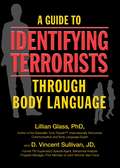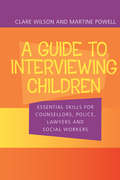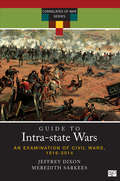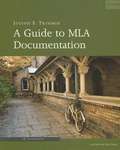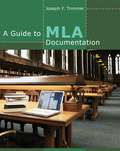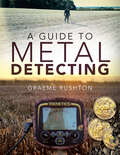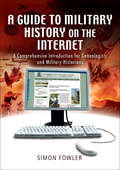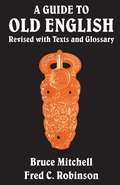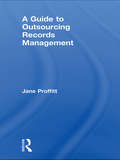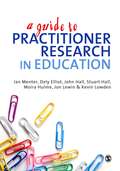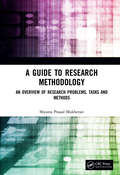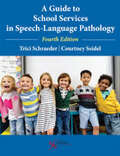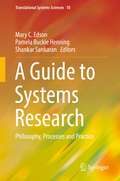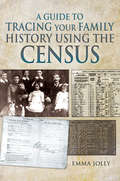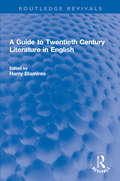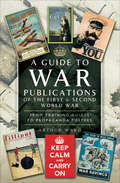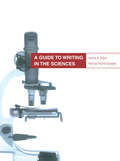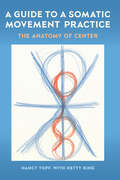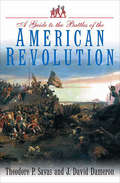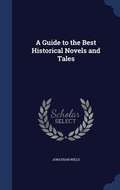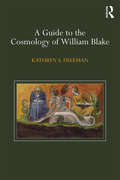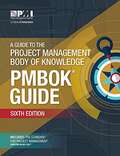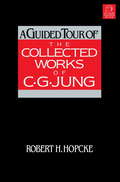- Table View
- List View
A Guide to Identifying Terrorists Through Body Language
by Lillian GlassIt’s not just Osama Bin Laden anymore.It’s the people all around you - from coworkers to your next-door neighbor. From domestic terrorists and serial killers to troubled students and homicidal exes, violent people are living right here among us.But we don’t have to count on patience and providence to get us through. In A Guide to Identifying Terrorists Through Body Language, renowned body-language expert and bestselling Toxic People author Dr. Lillian Glass reveals the visual cues, characteristics, and behaviors we need to identify the most dangerous people in our midst - in only seconds. In this book she teams up with former FBI Special Agent D. Vincent Sullivan where they both draw upon decades of experience. Her expertise in body language, vocal forensics, and behavioral analysis, and his experience as a former member of the Joint Terrorist Task Force provide you with the the same instruction, information, and insight they have provided to law enforcement, the justice system, and Homeland Security, among others. Complete with real-life scenarios and case studies, this groundbreaking handbook is the protection we upstanding citizens need to keep ourselves, our families, and our society free from harm.
A Guide to Interviewing Children: Essential Skills for Counsellors, Police Lawyers and Social Workers
by Claire Wilson Martine PowellChildren may be witnesses to crimes or accidents, or suspected victims of abuse or neglect, or they may be involved in some form of legal action such as custody cases. In these situations, they may need to be interviewed formally, and if this is not done properly, incorrect or inadequate information may be recorded or the child's position may not be correctly represented later in court. In cases of child abuse, the child may not be the only witness, and the quality of their verbal evidence is critical.A Guide to Interviewing Children is a practical guide the evidential interviewing techniques needed by a range of professionals: social workers, forensic psychologists, lawyers, police and teachers. It outlines basic techniques, explains how to deal with children of different ages (from pre-school to fifteen years), how to deal with parents, the particular issues of sexual abuse, handling multiple interviews of one child and so on. It is written for an international readership, and will be more practical and cover a broader range of contexts than the other titles currently available.
A Guide to Intra-state Wars: An Examination of Civil, Regional, and Intercommunal Wars, 1816-2014
by Jeffrey S. Dixon Meredith Reid SarkeesSourcing data and analyses from the rigorous Correlates of War Project, A Guide to Intra-state Wars describes how civil war is defined and categorized and presents data and descriptions for nearly 300 civil wars waged from 1816 to 2014. Analyzing trends over time and regions, this work is the definitive source for understanding the phenomenon of civil war, bringing together an explanation of the theoretical premises driving the Correlates of War Project, along with revisions to categories of, and actors in, civil wars that have been made over the years, and data from the Nations, States and Entities civil war dataset. Features: Provides detailed case studies of nearly 300 civil wars from 1816 to 2014. Combines the systematic study of war with analyses of trends over time and regions. Includes discussion of the different types of actors in international relations and presents data from the Nations, States, and Entities dataset. Considers data describing non-state participants (rebels) in civil wars.
A Guide to Intra-state Wars: An Examination of Civil, Regional, and Intercommunal Wars, 1816-2014
by Jeffrey S. Dixon Meredith Reid SarkeesSourcing data and analyses from the rigorous Correlates of War Project, A Guide to Intra-state Wars describes how civil war is defined and categorized and presents data and descriptions for nearly 300 civil wars waged from 1816 to 2014. Analyzing trends over time and regions, this work is the definitive source for understanding the phenomenon of civil war, bringing together an explanation of the theoretical premises driving the Correlates of War Project, along with revisions to categories of, and actors in, civil wars that have been made over the years, and data from the Nations, States and Entities civil war dataset. Features: Provides detailed case studies of nearly 300 civil wars from 1816 to 2014. Combines the systematic study of war with analyses of trends over time and regions. Includes discussion of the different types of actors in international relations and presents data from the Nations, States, and Entities dataset. Considers data describing non-state participants (rebels) in civil wars.
A Guide to MLA Documentation with an Appendix on APA Style
by Joseph F. TrimmerBriefer, cheaper, and easier to use than the MLA's own handbook, this popular booklet features current MLA guidelines, a new section on evaluating online sources, and an up-to-date APA appendix. The guide also provides numerous examples, a sample research paper, and helpful hints on such topics as avoiding plagiarism and taking notes.
A Guide to MLA Documentation: with an Appendix on APA Style
by Joseph F. TrimmerBriefer, more affordable, and easier to use than the MLA's own handbook, this popular booklet features current MLA guidelines, a new section on evaluating online sources, and an up-to-date APA appendix. The guide also provides numerous examples, a sample research paper, and helpful hints on such topics as avoiding plagiarism and taking notes.
A Guide to Metal Detecting
by Graeme RushtonThe aim of this book is to provide detailed information, practical help, handy hints and tips in regards to all aspects of Metal Detecting. By offering advice and guidance this book aims to make the hobby of using a metal detector fun, interesting and interactive to anyone who wishes to have a go! It will give the reader an insight into following best practice and how to enjoy the hobby in a responsible way, everything will be covered from choosing the right detector & equipment to gaining permission to search land, understanding the law and of course giving the necessary information to make sure that people enjoy their hobby to its maximum potential. From beaches to farmland we want you to be able to feel confident enough to search these types of environments and make interesting discoveries without feeling out of your depth. Information will be passed over regarding potential discoveries of treasure and the law surrounding such finds and also the identification of coins and artefacts that the reader may come across in their adventures. After reading this book, you will be able to enjoy this magical and captivating past-time and have the confidence to unearth some fascinating and historical discoveries.
A Guide to Microsoft Office 2010
by Jan MarrelliThe primary objective in this text is to teach 21st century skills through a project-based, hands-on approach. To meet this objective, we correlated the text to the National Standards for Business Education and used our teaching experiences, as well as the feedback, comments, and suggestions from other experienced educators to determine how best to present application concepts.
A Guide to Military History on the Internet: A Comprehensive Introduction for Genealogists and Military Historians
by Simon FowlerThere are thousands of websites devoted to all aspects of military history from ancient Greece to the modern Gulf. This unique book helps you find the ones that will help with your research whether you are checking out a soldier ancestor or an airman or researching a naval campaign. It also features sites that are entertaining or controversial. Sections cover the British armed services and their long military history, but the author also describes in detail websites that focus on American and Canadian forces. A Guide to Military History on the Internet is a companion volume to Pen & Sword's best-selling Tracing Your Army Ancestors by the same author.
A Guide to Old English: Revised with Texts and Glossary (The Royal Society of Canada Special Publications)
by Bruce Mitchell Fred RobinsonA Guide to Old English has established itself as the most thorough and most stimulating introduction to the language of Anglo-Saxon England. This revised edition adds ten basic texts, together with full notes and a comprehensive glossary, which convert the Guide into a self-contained course book for students beginning a study of Old English. The texts, such as Cynewulf and Cyneheard, the story of Caedmon and the conversion of Edwin, are those that have traditionally been chosen by teachers precisely becasue they offer the best introduction to the literature and culture of the time. They are arranged in order of increasing difficulty. The notes and glossary constantly refer to the grammatical explanations in the Guide, so that course is fully integrated and easy to follow.
A Guide to Outsourcing Records Management
by Jane ProffittOutsourcing is a global phenomenon that has enjoyed rapid growth over recent years, evidenced by the proliferation of outsourcing service providers in all areas of business. The concept centres on businesses and organizations divesting themselves of essential, but non-core, business activities and, properly managed, can realize considerable cost and other benefits for both the service provider and the outsourcing client. This book is a distillation of the outsourcing process, and is derived from detailed and wide-ranging research of the subject, but contextualised to cater for the records management environment. Outsourcing is not, however, necessarily the way ahead for every organization or business. The process of determining whether the concept is feasible, cost-effective and beneficial is complex and should not be entered into lightly. The price of failure is high and, for that reason, any outsourcing initiative demands robust project management skills, strong support at board level and the unremitting support and commitment of every executive, departmental head and senior manager in the company. Particularly so in the case of such an overarching entity as the records management facility because all are major stakeholders in the outcome. Much has been written about the concepts of outsourcing. Research has revealed numerous books, journal articles and case studies attesting to the relative merits but there is little to nothing available that is specific to a Records Management facility. This title will prove invaluable for any librarian or information professional with a practical or academic interest in outsourcing, or any students in the field of library science.
A Guide to Practitioner Research in Education
by Ian Menter Dely Elliot Moira Hulme Jon Lewin Kevin LowdenDrawing on short texts that were produced by the former Scottish Council for Research in Education (SCRE), Menter et al. (education, U. of Glasgow, UK), some whom have worked in the SCRE, introduce education students and experienced teachers to practitioner research. They explain what it is and what it means for teachers, lecturers, and other education professionals; why to engage in it, such as for initial teacher education, school improvement, or policy development; and its elements: the research question, values and ethics, secondary data, the literature review, questionnaires, interviewing, focus groups, observation, and other methods like using photos, diaries, and drawings. They end with explanation of quantitative and qualitative data analysis and sharing research. Annotation ©2012 Book News, Inc. , Portland, OR (booknews. com)
A Guide to Research Methodology: An Overview of Research Problems, Tasks and Methods
by Shyama Prasad MukherjeeResearch Methodology is meant to provide a broad guideline to facilitate and steer the whole of a research activity in any discipline. With the ambit and amount of research increasing by the day, the need for Research Methodology is being widely appreciated. Against this backdrop, we notice the dearth of well-written books on the subject. A Guide to Research Methodology attempts a balance between the generic approach to research in any domain and the wide array of research methods which are to be used in carrying out different tasks in any research. Discussions on these research methods appropriate in various disciplines have focused on the research tasks, keeping in mind the fact that a single such task like a comparison among alternatives may involve several methods from seemingly distinct areas. Unique features of this volume, as will be evident to a discerning reader, include: A detailed discussion on problem areas for research in several domains An illustrative and ampliated list of research problems drawn from different disciplines which can be pursued by interested research workers A comprehensive delineation of Research Design supported by illustrations An elaborate engagement with models with a note on model uncertainty Focus on recent and emerging models, methods and techniques A novel treatment of data analysis where the nature of data and the objective(s) of analysis justify drawing upon a variety of techniques for analysis This book will serve the purpose of a pre-PhD or a Master-level course-work for students of any discipline with a basic knowledge of quantitative analysis. In fact, anyone aspiring to take up meaningful research work will find the content useful and interesting.
A Guide to School Services in Speech-Language Pathology
by Trici Schraeder Courtney SeidelA Guide to School Services in Speech-Language Pathology, Fourth Edition serves as a comprehensive textbook for school-based speech-language pathology (SLP) courses and college students who are ready to embark on their student teaching experiences. With its summaries of cutting-edge research, evidence-based clinical approaches, workload solutions, and strategies for professionalism, the book is also a useful resource for practicing, school-based SLPs. The text begins by providing a brief history of school-based SLP services. It highlights the legal mandates set forth in the Individuals with Disabilities Education Improvement Act; provides a review of the No Child Left Behind Act; offers new information about the Every Student Succeeds Act and the Americans with Disabilities Act; and summarizes court cases that have influenced and shaped school services. Then, the text delves into a description of service delivery models; provides valuable information about a workload analysis approach to caseload standards in schools; offers examples of how to write IEPs that reflect workload solutions; shares examples of implementation strategies; and offers concrete, real-life workload success stories. In addition, this text provides practical strategies for using evidence-based practice, proactive behavior management, conflict resolution, professional collaboration, conferencing and counseling skills, cultural competencies, goal writing, informal assessment procedures, and testing accommodations, including methods for conducting assessments for dual language learners. The final chapter provides the evidence base for links between language, literacy, and the achievement of school standards. This chapter is a must-read for every school SLP.
A Guide to Systems Research: Philosophy, Processes and Practice (Translational Systems Sciences #10)
by Mary C. Edson Pamela Buckle Henning Shankar SankaranThis guide is designed for systems researchers - emerging and seasoned - searching for holistic approaches of inquiry into complexity, which the Systems Sciences provide. The authors share insight into the foundations of research that are not only systematic in terms of rigor, but systemic in perspective, analysis, design, development, implementation, reporting, and evaluation. This guide also explores researcher competencies necessary to conduct sound systems research. Researchers using this guide will gain understanding of what distinguishes systems research from other types of research and why it is important in research today.
A Guide to Tracing Your Family History Using the Census
by Emma JollyHow to use British census records in your genealogical research—includes an appendix of key resources.The census is an essential survey of our population, and it is a source of basic information for local and national government and for various organizations dealing with education, housing, health and transport. Providing the researcher with a fascinating insight into who we were in the past, Emma Jolly’s new handbook is a useful tool for anyone keen to discover their family history. With detailed, accessible and authoritative coverage, it is full of advice on how to explore and get the most from the records.Each census from 1841 to 1911 is described in detail, and later censuses are analyzed too. The main focus is on the census in England and Wales, but censuses in Scotland, Ireland, the Channel Islands and the Isle of Man are all examined and the differences explained. Particular emphasis is placed on the rapidly expanding number of websites that offer census information, making the process of research far easier to carry out. The extensive appendix gathers together all the key resources in one place.Emma Jolly’s guide is an ideal introduction and tool for anyone who is researching the life and times of an ancestor.
A Guide to Twentieth Century Literature in English (Routledge Revivals)
by Harry BlamiresFirst published in 1983, A Guide to Twentieth Century Literature in English is a detailed and comprehensive guide containing over 500 entries on individual writers from countries including Africa, Australia, Canada, the Caribbean, India, Ireland, New Zealand, Pakistan, Sri Lanka, and the UK. The book contains substantial articles relating to major novelists, poets, and dramatists of the age, as well as a wealth of information on the work of lesser-known writers and the part they have played in cultural history. It focuses in detail on the character and quality of the literature itself, highlighting what is distinctive in the work of the writers being discussed and providing key biographical and contextual details. A Guide to Twentieth Century Literature in English is ideal for those with an interest in the twentieth century literary scene and the history of literature more broadly.
A Guide to War Publications of the First & Second World War: From Training Guides to Propaganda Posters
by Arthur WardA &“fascinating&” guide to war propaganda of WWI and WWII, from &“Loose Lips Sink Ships&” to &“Keep Calm and Carry On&”—includes vintage images (Firetrench). A Guide to War Publications of the First & Second World War is devoted to the printed ephemera that was designed to educate, instruct, inform, and entertain during the first and second World Wars. This includes soldiers&’ Field Regulations, updates airmen received about airborne early warnings, bomb sights, and radio navigation, and materials sailors were given to help them identify enemy aircraft and operate new weapons on submarines. This comprehensive guide illustrates the large amount of material produced during the war by looking at encouraging wartime sayings such as: &“Go To IT!,&” &“Come Into The Factories,&” &“Keep Calm and Carry On,&” &“Dig for Victory,&” &“Lend A Hand on the Land,&” and &“Walk When You Can.&” While showing how other messages warned of consequences to irresponsible behavior: &“Careless Talk Cost Lives,&” &“Loose Lips Sink Ships,&” &“Keep It Under Your Hat,&” and &“Be Like Dad, Keep Mum.&” Arthur Ward gives information on what propaganda was produced, what items are still available and where to find them, and how to conserve and store vintage printed items.
A Guide to Writing in the Sciences
by Patricia Patchet-Golubev Andrea A. GilpinWhile teaching writing to undergraduate science students, Gilpin and Patchet-Golubev discovered that although many relatively sophisticated manuals for scientific writing exist, most are aimed at mainly professionals or specialists and are of little practical use to the majority of students. This introductory guide fills that large gap.Direct and friendly in tone the book provides clear and concise explanations of the basic elements of scientific writing required of students. The various genres are detailed -- in particular lab reports and research essays - as well as scientific articles, poster presentations, proposals, and even essay exams. Similarities and differences among these genres are underlined in order to illustrate structural principles and to provide practical writing tips. A detailed chapter covers the elements of grammar and punctuation that are fundamental to all good writing; it also outlines some key points about scientific style in particular.Using accessible language throughout, the authors organize their material with helpful lists, copious examples, and boxed writing and research tips. There are several useful appendices (including a classification chart of organisms and an international units conversion chart), an index, and selected bibliography on science and technical writing. Unique in its field, this guide offers a practical and valuable guide to the basic principles and conventions of science writing.
A Guide to a Somatic Movement Practice: The Anatomy of Center
by Nancy TopfAn introduction to embodied movement through the work of a dance education pioneer In this introduction to the work of somatic dance education pioneer Nancy Topf (1942–1998), readers are ushered on a journey to explore the movement of the body through a close awareness of anatomical form and function. Making available the full text of Topf’s The Anatomy of Center for the first time in print, this guide helps professionals, teachers, and students of all levels integrate embodied, somatic practices within contexts of dance, physical education and therapy, health, and mental well-being. Hetty King, a movement educator certified in the Topf Technique®, explains how the ideas in this work grew out of Topf’s involvement in developing Anatomical Release Technique—an important concept in contemporary dance—and the influence of earlier innovators Barbara Clark and Mabel Elsworth Todd, founder of the approach to movement known as “ideokinesis.” Featuring lessons written as a dialogue between teacher, student, and elements of the body, Topf’s material is accompanied by twenty-one activities that allow readers to use the book as a self-guided manual. A Guide to a Somatic Movement Practice is a widely applicable entry point into the tradition of experiential anatomy and its mindful centering of the living, breathing body.
A Guide to the Battles of the American Revolution
by J. David Dameron Theodore P. SavasA Guide to the Battles of the American Revolution is the first comprehensive account of every engagement of the Revolution, a war that began with a brief skirmish at Lexington Green on April 19, 1775, and concluded on the battlefield at the Siege of Yorktown in October 1781. In between were six long years of bitter fighting on land and at sea. The wide variety of combats blanketed the North American continent from Canada to the Southern colonies, from the winding coastal lowlands to the Appalachian Mountains, and from the North Atlantic to the Caribbean. Unlike existing accounts, A Guide to the Battles of the American Revolution presents each engagement in a unique way. Each battle entry offers a wide and richbut consistenttemplate of information to make it easy for readers to find exactly what they are seeking. Every entry begins with introductory details including the date of the battle, its location, commanders, opposing forces, terrain, weather, and time of day. The detailed body of each entry offers both a Colonial and British perspective of the unfolding military situation, a detailed and unbiased account of what actually transpired, a discussion of numbers and losses, an assessment of the consequences of the battle, and suggestions for further reading. Many of the entries are supported and enriched by original maps and photos. Fresh, scholarly, informative, and entertaining, A Guide to the Battles of the American Revolution will be welcomed by historians and general enthusiasts everywhere.
A Guide to the Cosmology of William Blake
by Kathryn S. FreemanIt is not surprising that visitors to Blake’s cosmology – the most elaborate in the history of British text and design – often demand a map in the form of a reference book. The entries in this volume benefit from the wide range of historical information made available in recent decades regarding the relationship between Blake’s text and design and his biographical, political, social, and religious contexts. Of particular importance, the entries take account of the re-interpretations of Blake with respect to race, gender, and empire in scholarship influenced by the groundbreaking theories that have arisen since the first half of the twentieth century. The intricate fluidity of Blake’s anti-Newtonian universe eludes the fixity of definitions and schema. Central to this guide to Blake's work and ideas is Kathryn S. Freeman's acknowledgment of the paradox of providing orientation in Blake’s universe without disrupting its inherent disorientation of the traditions whereby readers still come to it. In this innovative work, Freeman aligns herself with Blake’s demand that we play an active role in challenging our own readerly habits of passivity as we experience his created and corporeal worlds.
A Guide to the Project Management Body of Knowledge
by Project Management InstituteThe PMBOK(R) Guide - Sixth Edition - PMI's flagship publication has been updated to reflect the latest good practices in project management. New to the Sixth Edition, each knowledge area will contain a section entitled Approaches for Agile, Iterative and Adaptive Environments, describing how these practices integrate in project settings. It will also contain more emphasis on strategic and business knowledge-including discussion of project management business documents-and information on the PMI Talent Triangle(TM) and the essential skills for success in today's market.
A Guided Tour of the Collected Works of C. G. Jung
by Robert H. HopckeThe writings of C. G. Jung himself are the best place to read about all his main ideas--but where to start, when Jung's Collected Works run to more than eighteen volumes? Robert H. Hopcke's guide to Jung's voluminous writings shows exactly the best place to begin for getting a handle on each of Jung's key concepts and ideas--from archetypal symbols to analytical psychology to UFOs. Each chapter explains one of Jung's principal concerns, then directs the reader where to read about it in depth in the Collected Works. Each chapter includes a list of secondary sources to approach for further study--which the author has updated for this edition to include books published in the ten years since the Guided Tour's first appearance.
